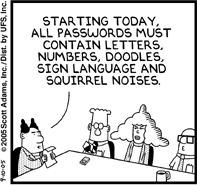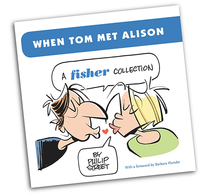
A comic strip is a sequence of drawings, often cartoon, arranged in interrelated panels to display brief humor or form a narrative, often serialized, with text in balloons and captions. Traditionally, throughout the 20th and into the 21st century, these have been published in newspapers and magazines, with daily horizontal strips printed in black-and-white in newspapers, while Sunday papers offered longer sequences in special color comics sections. With the advent of the internet, online comic strips began to appear as webcomics.

Dilbert is an American comic strip written and illustrated by Scott Adams, first published on April 16, 1989. The strip is known for its satirical office humor about a white-collar, micromanaged office featuring engineer Dilbert as the title character. The strip has spawned dozens of books, an animated television series, a video game, and hundreds of Dilbert-themed merchandise items. Dilbert Future and The Joy of Work are among the most read books in the series. Adams received the National Cartoonists Society Reuben Award in 1997 and the Newspaper Comic Strip Award in the same year for his work on the strip. Dilbert appears online and as of 2013 was published daily in 2,000 newspapers in 65 countries and 25 languages.

Bluto is a cartoon and comics character created in 1932 by Elzie Crisler Segar as a one-time character, named "Bluto the Terrible", in his Thimble Theatre comic strip. Bluto made his first appearance September 12 of that year. Fleischer Studios adapted him the next year (1933) to be the main antagonist of their theatrical Popeye animated cartoon series.

Nutty was a British comic magazine that ran for 292 issues from 16 February 1980 to 14 September 1985, when it merged with The Dandy. Published by D. C. Thomson & Co. Ltd, Nutty was an attempt to create a more lively and chaotic comic compared to many on sale at the time. Its strips included:

Bananaman is a fictional character appearing in British comic books. Bananaman is a parody of traditional superheroes, being portrayed as a schoolboy who is transformed into a muscled, caped figure when he eats a banana. The character originally appeared in Nutty as the back page strip in Issue 1, dated 16 February 1980 drawn by John Geering.

The Dandy was a British children's comic magazine published by the Dundee based publisher DC Thomson. The first issue was printed in December 1937, making it the world's third-longest running comic, after Il Giornalino and Detective Comics. From August 2007 until October 2010, it was rebranded as Dandy Xtreme.

Beryl the Peril is a fictional character created by David Law, the creator of Dennis the Menace, for issue 1 of The Topper comic published by DC Thomson & Co. Limited. Like Dennis, she had black and red apparel, and devilishly tormented her parents and other members of her community. Despite not having quite as many appearances as other DC Thomson characters such as Dennis the Menace or Desperate Dan, Beryl is still considered one of the classic characters which define the popularity of British comics.

Sonic the Comic was a British children's comic published by Fleetway Editions between 1993 and 2002. It was the UK's Sega comic, featuring stories about its mascot Sonic the Hedgehog and related characters, as well as comic strips based on other Sega video games, along with news, reviews, and tips for games released for Sega systems.

Life in Hell is a comic strip by Matt Groening, creator of The Simpsons, Futurama, and Disenchantment, which was published weekly from 1977 to 2012. The strip features anthropomorphic rabbits and a gay couple. The comic covers a wide range of subjects, such as love, sex, work, and death, and explores themes of angst, social alienation, self-loathing, and fear of inevitable doom.
Count Your Sheep is a webcomic written and illustrated by Adrian Ramos, generally known as Adis. It was launched in 2003 on the Keenspace hosting service and became part of Keenspot a year later. It is also part of the Quicksketch Comics collective. As of January 2006, it had a hair under 10,000 steady readers. As of July 2007, the first comics are available in print in the first Count Your Sheep book titled Relatives and Sedatives.

Speech balloons are a graphic convention used most commonly in comic books, comics, and cartoons to allow words to be understood as representing the speech or thoughts of a given character in the comic. Often, a formal distinction is made between the balloon that indicates thoughts and the one that indicates words spoken aloud; the balloon that conveys thoughts is often referred to as a thought bubble or conversation cloud.

Fisher is a Canadian comic strip, which ran daily exclusively in The Globe and Mail from 1992 to September 2012. On 8 September 2012, the last strip was published in the Globe after the paper decided to drop the comic as part of a reorganization of the page. After its cancellation it restarted as a web only comic. In May 2013 the first book collection of Fisher strips was published by Nestlings Press in Toronto. Titled "When Tom Met Alison", it details the courtship of the two leading characters in the strip.
A daily strip is a newspaper comic strip format, appearing on weekdays, Monday through Saturday, as contrasted with a Sunday strip, which typically only appears on Sundays.

The Sunday comics or Sunday strip is the comic strip section carried in most western newspapers, almost always in color. Many newspaper readers called this section the Sunday funnies, the funny papers or simply the funnies.
"Grimly Fiendish" is a single by the Damned, released in 1985.

Ziggy is an American cartoon series created by Tom Wilson, a former American Greetings executive, and distributed by Andrews McMeel Syndication. In 1987, his son Tom Wilson II took over writing and drawing the comic strip.
Sesame Street is a nationally syndicated comic strip inspired by Sesame Street. Written and drawn by veteran Sesame animator Cliff Roberts, the earliest concept art was created in 1970, and by 1971, a promotional booklet was created as the comic entered the market, courtesy of King Features. The strip debuted on November 15, 1971, in more than 175 newspapers, and ran until 1975. The strip, which ran both daily and on Sundays, was conceptually similar to the series in its pedagogical goals, but, in the first year of the strip, conspicuous by the absence of the Muppets.
Disney Christmas Story is an American Disney comic strip that appeared each year in the weeks before Christmas, beginning in 1960. The strip ran Monday to Saturday for the three to four weeks leading up to Christmas Eve, and often promoted the latest Disney release or re-release. The strips were usually not published on the newspaper's comics page; they appeared at the bottom of the page somewhere else in the paper, so that the reader would have to hunt for it, and not-coincidentally pass by some of the Christmas advertising. The strip appeared every year until 1987.